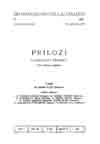Institucija modalnih glagola i njihovih ekvivalenata u savremenom arapskom jeziku
The instituition of modal verbs and their equivalents in contemporary arabic language
Author(s): Drenka CrevarSubject(s): Language and Literature Studies
Published by: Orijentalni Institut u Sarajevu
Summary/Abstract: This work attempts to identify those elements which make up and characterize the institution of modal verbs and thelr equivaJents in the contemporary Arabic language. Modal verbs and their equivalents (M) are lexical means of expression of a segment of modality (verbal modality) and have the function of conveying semantic information on the modal disposition (necessary, possible, desired) of the agent to realize a certain action. The deductive method has been applied in the identification of modal verbs and their equivalents, so that, depending on their function, they are distinguished from other verbs and expressions which introduce complementary clauses (verbs expressing necessity: yanbagi, yagibu, their equivalents cala, la budda and verbs expressing shades in their meaning: yahsunu, yahuqqu, yagduru, yaliqu, yustahsanu, the verb expressing possibility amkana, and verbs expressing shades in its meaning: sumiha, gaza, istataca, the verb expressing intention arada and those expressing shades in its meaning: ragiba, ša'a, ahabba, wadda). Further, by applying the method of distribution an analysis has been made of their syntactic, formal and semantic characteristics, on the understanding that they are characterized by different specificities which together function as a complex of elements the correlation of which provides a basis for drawing conclusion on what forms the institution of M in a given language.
Journal: Prilozi za orijentalnu filologiju
- Issue Year: 1985
- Issue No: 34
- Page Range: 17-44
- Page Count: 28
- Language: Serbian

